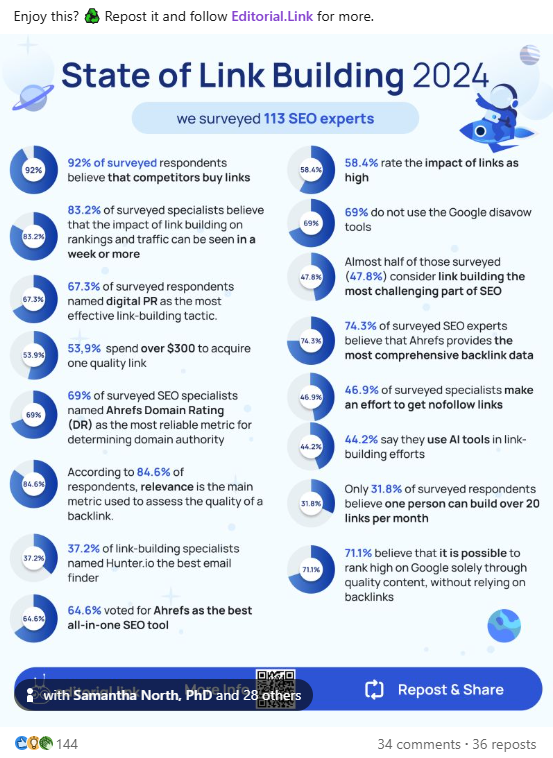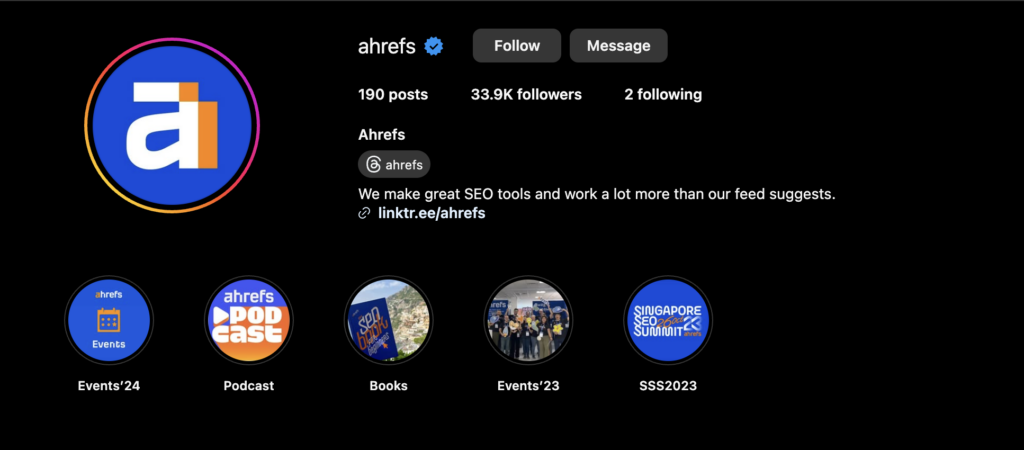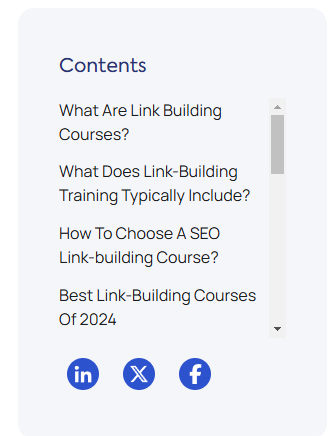Let's face it: social media backlinks, like those in your LinkedIn profile or X posts, aren't considered a high-value commodity in the SEO space.
The main reason? They're nofollow.
But does it mean they are a complete waste of your time?
Not exactly.
In the article, I'll explain how such links can benefit your SEO strategy, and if they can harm it. I'll also share a few best practices for using social media to build links.
What Are Social Media Backlinks?
Social media backlinks can appear in your 'about' sections, bios, comments, or posts shared on social media platforms like LinkedIn, Twitter, Instagram, and Facebook.
For example, our LinkedIn profile has a link to our website (the 'Visit website' button.)

Here's one of our tweets, in which we share one of our blog posts.

And here's a Facebook post featuring an infographic and a link to the article it's based on.

Are Social Media Backlinks Worth It?
Here’s the million-dollar question: are links from social media worth your time?
The short answer is yes. But it's complicated.
Let me explain by unpacking the pros and cons of social backlinks.
Pros of Social Media Backlinks
Building links using social media offers a few advantages.
Low barriers to entry
Along with forum links, social media links are probably the easiest ones to get.
Because you're in charge. You add links to your profile, share content, or choose whose content you want to engage with. This means it's an easy way to get some backlinks for new businesses that are only starting with their link-building efforts.
However, this also means that everyone and their dog does it, which reduces the value of the links.
When you want to maximize the potential of your social media pages, for example, to increase your reach, things get challenging. More about it below when I talk about life span and algorithms.
Increased brand visibility
In my opinion, increased brand visibility is the biggest advantage of social links. 5 billion people use social media every day – 143 minutes a day on average. By posting content across your social media platforms, you can get it in front of audiences that you wouldn't be able to reach otherwise.
And as Peter Lewis, the Founder and CEO of Strategic Pete, a marketing consultancy, points out, this happens much faster than through organic search:
Backlinks on social media tend to be more immediate and viral compared to traditional efforts in SEO. The more views and shares your content gets, the better the chances that it may appear in front of other people from other networks and circles.
But wait — there's more!
Consistent online presence allows you to build a relationship with the newly acquired audience. It isn't an SEO benefit but definitely a business one. Customers who feel connected to your brand are more likely to choose you over your competitors and spend more, Sprout Social has found.
'Real' link opportunities
Although social media links don't pass link equity because of the nofollow attribute (more about it in a moment), they can help you secure actual backlinks.
As your valuable content gets shared across social media, it reaches people who use it in their work and give you a link. I use social media for research and if I find a valuable resource, I'm more than happy to link to it in my articles.
And we've benefited from this at Editorial.Link too. Our LinkedIn post promoting our State of Link Building report got decent engagement and 36 reposts. Organic links followed.

Referral traffic
Increased social media exposure brings more traffic to your website.
The benefit is obvious. More traffic means more leads.
And these are often prequalified leads warmed through your social media activity. They already know what you do and what you stand for, so they're more likely to purchase your product or service.
Indirect SEO benefits
Traffic from social media can also indirectly improve your SERP performance.
Contrary to what many believe, the Google API leak revealed nothing about the impact of clicks or traffic on rankings.
Yes, these are obviously correlated because pages that rank higher, have higher CTR rates and more traffic. But there's no evidence it's the other way around.
However, Google considers user engagement when ranking your page. High bounce rates or dwell time can indicate that the page is irrelevant. But as I mentioned, visitors who access your website content through social media know what to expect from it, and consequently are less likely to bounce.
Moreover, a study by CognitiveSEO has found that there's a correlation between social signals, like shares, comments, and likes, and higher rankings.
How so?
SEOs believe they indicate user trust and make your website come across as more authoritative.

In other words, if lots of people engage with your content on social media, it may be seen as the go-to resource on the subject, which Google considers for ranking:

Natural backlink profile
Finally, social media links make your backlink profile more natural.
Think about it:
If there are over 5 billion social media users in the world and your pages have dozens of backlinks, it would be very odd if they didn't have any social mentions or shares.
Cons of social media links
Having covered the pros of social media, let's now look at the downsides of this link-building strategy.
1. Nofollow Links
As mentioned, the biggest drawback of links in social media profiles, posts, or comments is that they come with the rel=nofollow attribute. This means they don't pump link juice to your site.
Well, dofollow links are generally more desirable. You can't argue with that.
However, the nofollow tag isn’t what it used to be. In 2019, Google changed how it views the attribute. It treats it as a hint of how important the link is, but it doesn't automatically dismiss it.

So, such links may influence search engine rankings. In fact, some people I've talked to over the last year, like Andrew Holland or James Brockbank, believe that they are equally powerful (at least, when we talk about digital PR links.)
2. Short live span
If you're doing social media link building for the traffic and increased online visibility, and not PageRank, then its impact is fairly short-lived.
Unlike links provided from high-quality websites or blogs, which can provide more long-term SEO benefits, most social media links just do not have the same longevity. While they may spur quite a lot of traffic for some time, it is short-lived since these links are ultimately buried with fresh posts and content.
The consequence? Effective social media engagement requires a consistent posting strategy. Which is resource-intensive.
3. Algorithms
Sometimes, your posts might not even reach your target audience if you don't know how to navigate the platform algorithms.
For example, LinkedIn prioritizes content that gets lots of engagement, especially lengthy comments in the first 2 hours. This makes it hard for new creators to break through. One way to do it is by engaging with others' content—it feeds the algo and increases the chances they reciprocate by engaging with your content.
This takes time and even if you finally hack the system, there are no guarantees that the platform doesn't change its algorithms.
Algorithm changes, however, are an inherent part of the SEO game. After the rollercoaster of 2023/24, you should be used to it now.
4. Risk of over-spamming
Finally, don't fall into the trap of overusing links in your social media marketing.
If your content feels too self-promotional, it can alienate your audience. You can even get flagged for spammy behavior. Groups, like Facebook ones, are particularly sensitive about it, and it can result in bans.
How do you avoid it while keeping a steady posting cadence?
Focus on providing value. For every post that includes a link, aim to publish two or three that simply engage your audience with helpful content, like the carousel with a link-building checklist I created.

How to Track Your Social Media Backlinks
How do you know if your social backlinks are driving the traffic you expected?
You track them.
The best way to do so it is by using UTM parameters. These are small bits of code added to your URLs that help you identify where your traffic is coming from.
For example:
https://yourwebsite.com/?utm_source=linkedin&utm_medium=social&utm_campaign=case_20study
Here’s how to set it up:
- Use a free tool like the Google Campaign URL Builder.

- Fill in the fields for source (e.g., LinkedIn), medium (e.g., social), and campaign (e.g., blog_post).

- Generate the URL, shorten it using one of the dozens of free tools on the web, and add it to your social media posts.

You can then track these links in Google Analytics (GA4) under Acquisitions > Traffic acqusition > All Campaigns.

Also, consider using tools like Hootsuite to monitor user engagement with your content across all your social media accounts.
Social Media Backlinks You Must Build
Start building links through social media by picking these low-hanging fruits.
With over 1 billion users and 67 million company profiles, LinkedIn is the largest social network for professionals and businesses.
- Add links to your website in your Contact Info section.

- Promote the most valuable blog posts or case studies in the Featured section.

- Share posts with valuable content and link back to your website.

Pro tip: LinkedIn algos promote content from personal accounts over company account.
With over 3 billion users, Facebook remains the most popular social network. It's also most used by marketers and offers the highest ROI.
- Use the “About” section on your page to include a link to your website.

- Share blog posts and include a link in each post.

- Pin a post with your most important link in the Featured section.

Twitter X
X currently has about 620 million users worldwide, and over 60% of them are men. Although most users use it for news, it's also popular among professionals.
- Add your website link in your bio.

- Include a link in every tweet that shares blog posts or product updates.

Instagram is the third biggest social network. It has over 2 billion active monthly users. Over 55% of them are women. Most users are located in the States, followed by India and Brazil.
- Use the link in your bio strategically. Add your most valuable link, for example, to an event you're promoting or your demo.

- Add links to your Instagram Stories.

YouTube
Youtube is the second biggest of the social platforms. It has over 2.5 billion users. The biggest demographic group is males aged 25-44. Most users watch YouTube vidoes on mobile devices (90%), so optimize your content accordingly.
- Add links to your website in your channel’s About section.

- Include links in your video descriptions for more visibility.

TikTok
TikTok has over 1 billion users all over the world. An average users spends nearly 95 minutes on TikTok every day, and it's the fastest-growing network.
The only place where you can add the link is the bio.

How to Build More Social Backlinks
Let's finish with a few tips on how to maximize your social link-building efforts.
- Create content worth sharing: Compelling content is the foundation of any link-building efforts, but it's particularly important for securing social media backlinks. Think infographics, videos, and blog post summaries.
Pro tip: Social media algos promote content that keeps users on the platform. To prevent your content from getting buried, put the link in the comments, not in the post body.
- Add share icons to your website: to make it easy for visitors to share your content on social media.

- Collaborate with Influencers: Partnering with influencers in your niche can amplify your content’s reach. I recently teamed up with Ben Goodey, the founder of Spicy Margarita and How the F*ck, who's got 46,700 followers on LinkedIn. His post got 25 reposts, and mine only 7.

At Skylum, we like to work with influencers. Since we make image-editing software, we collaborate with photography influencers and professional photographers on social media, like Instagram and Facebook, for instance. We’ve found this strategy extremely useful because we not only get backlinks and exposure but also quality leads. That’s all due to the fact that we carefully pick our partners to make sure their audiences match our ideal users.
- Engage with niche communities: Join groups on LinkedIn or Facebook related to your industry. Share valuable insights and include links where relevant. Just remember: no spam, please.
- Host contests and giveaways: Use contests to encourage users to share your content. For example, a giveaway where participants must share a post, link back to your site, or tag a friend is a great way to gain traction.

Conclusion
Social media links are excellent for companies that start their journey. While their impact on SEO rankings is limited compared to other links, they drive traffic and engagement, helping you increase your brand visibility, get more leads, and ultimately achieve business goals.
However, you shouldn't rely on them as the only or main link-building strategy. Combine them with other tactics, like link insertions, guest posting or PR campaigns.
If you need help creating a balanced link-building strategy tailored to your goals, the Editorial.Link team can help. Get in touch!



